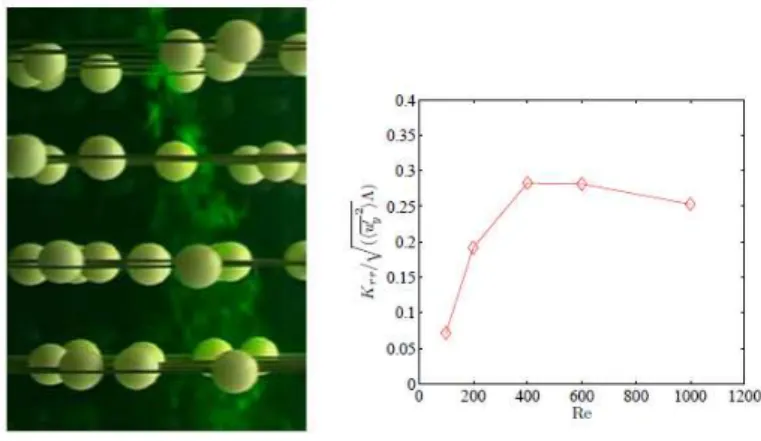Any correspondence concerning this service should be sent to the repository administrator:
staff-oatao@inp-toulouse.fr
Official URL:
remwallace.wix.com/etpfgm13
This is an author-deposited version published in:
http://oatao.univ-toulouse.fr/
Eprints ID: 9840
To cite this version:
Besnaci, Cédric and Risso, Frédéric and Roig, Véronique Mixing at high
Schmidt number in a random array of spheres. In: 51st European Two-Phase
Flow Group Meeting (ETPFGM2013), 13 May 2013 - 15 May 2013 (Lyon,
France). (Unpublished)
O
pen
A
rchive
T
oulouse
A
rchive
O
uverte (
OATAO
)
OATAO is an open access repository that collects the work of Toulouse researchers and
makes it freely available over the web where possible.
ETPFGM’13, Lyon, France, May 13-15 2013 .
Mixing at high Schmidt number in a random array of spheres
C. Besnaci
∗, F. Risso
∗, V. Roig
∗We present experimental results on the mixing of a passive scalar in a flow crossing a random array of spheres. A fluorescent dye having a low molecular diffusivity is injected through a point source in the array (Fig. 1) and we observe by planar laser induced fluorescence the concentration field in a large section transverse to the flow located at different longitudinal positions z from the source. The flow configuration is characterised by a solid volume fraction of 2%, Reynolds numbers of the spheres Re in the range 100 - 1000, a Schmidt number equal to 2000 and a ratio between the injector diameter and that of the spheres equal to 0.1. This study allows us to analyse the fundamental mechanisms controling the mixing in the turbulence inside the array, which is also representative of the agitation in dispersed flows such as swarms of bubbles 1. Somes important results have been obtained about mixing2.
They show that a transition exists in the mixing around Re =400. For lower Re the main mechanism of mixing is the direct interaction of the filament of dye with the local deformation of the flow in the vicinity of the spheres. At higher Re, the flow being destabilized, turbulence is present in the array and is responsible for the mixing. Our investigations show that one can introduce an effective diffusivity to model the mixing at large distances as compared to the integral length scale (Fig. 2). Moreover, the spatial spectrum of the concentration reveals that the mixing is controlled by different mechanisms depending on the wavenumber range that is considered.
∗Institut de M´ecanique des Fluides de Toulouse, Universit´e de Toulouse and CNRS, All´ee du Prof.
C. Soula, 31400 Toulouse, France
1Amoura, INPT PhD , Toulouse, France (2008). 2Besnaci, INPT PhD , Toulouse, France (2012).
